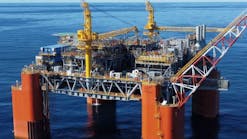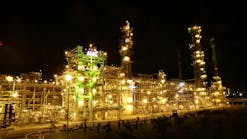U.S. oil and gas producers in 1995-96 will post one of their strongest recent showings, boosting gas flow and slowing the oil production slide.
So reports the supply/demand committee of the Independent Petroleum Association of America. The committee disclosed the forecast in mid-November at IPAAs annual meeting in San Diego.
IPAA predicts U.S. gas demand and production will increase this year and next.
Production wont increase enough to curtail imports of Canadian gas. But it will be big enough, given expected demand, to hold yearly import growth rates to single digits for the first time since 1991.
IPAAs oil outlook is mixed, with the decline of U.S. crude oil production expected to slow during 1995-96 and the mix of imports to change. U.S. crude production will show declines of about 1.7% to 6.5 million b/d in 1995 and 2.3% to 6.4 million b/d in 1996.
IPAA expects total U.S. petroleum imports in 1995 to slip 0.5% to 8.948 million b/d. Crude imports will register a 4.5% increase to 7.384 million b/d for the year, while products imports decline 19.1% to 1.564 million b/d.
Petroleum imports in 1996 will rise 2% to 9.123 million b/d, with crude imports increasing 3.2% to 7.623 million b/d and products declining 4.1% to 1.5 million b/d.
Despite relatively better upstream results in the U.S. in 1995-96, IPAA said, the decline of wells drilled, lower counts of active rigs, and other gauges of activity indicate U.S. oil and gas production and reserves will continue to slip.
For example, Baker Hughes Inc. predicted the count of active rotary rigs in the U.S. will average 721 in 1995 and 746 in 1996. In 1994, the companys count averaged 774.
IPAA bases its supply/demand outlook on assumptions that U.S. economic activity will increase 3.3% in 1995 and 2.6% in 1996. Meantime, the amount of energy required to generate a unit of U.S. gross domestic product in 1995 will drop to 15.7 MBTUthe first average of less than 16 MBTUand in 1996 to 15.6 MBTU.
As a result, U.S. energy demand in 1995 will rise 1.1% to 86.58 quadrillion BTUs (quads) and in 1996 1.8% to 88.16 quads.
Gas industry to grow
With exploration slanted toward gas prospects, IPAA expects U.S. operators to continue increasing gas production this year and next.
Production likely will rise 1.1% to 19.1 tcf in 1995 and 1.5% to 19.35 tcf in 1996.
IPAA said data through mid-1995 showed production essentially flat in the three top gas producing states in the Lower 48Texas, Louisiana, and Oklahomawhile production rose in Colorado, New Mexico, and the Gulf of Mexico. U.S. operators in 1994 replaced 110% of production to hike reserves to 163.8 tcf.
Gas flow will remain strong during off peak months, due largely to demand for immediate consumption and for storage fill. The U.S. gas industry increasingly has used storage to balance supplies with demand and in price hedging strategies since implementation of Federal Energy Regulatory Commission Order 636.
IPAA expects U.S. gas consumption in 1995 to be up 2.9%, reaching 21.3 tcf, the highest level since 1973. Economic growth, low gas prices, and gass environmental attributes are contributing to the increase.
Given normal winter weather, consumption in 1996 will rise 2.4% to 21.8 tcf as economic growth slows.
Gas will continue to capture market share from coal and fuel oil. IPAA expects respective 1995 and 1996 gas demand to grow 6.1% and 3% among electric utilities and 5.4% and 1.7% among industrial customers. Residential demand in 1996 will increase 3% after slipping a little in 1995. Commercial customers will increase gas use 2.6% in 1996 after a 1% increase this year.
Imports of Canadian gas will rise 6% to 2.78 tcf in 1995 and 4% in 1996 to 2.89 tcf. Lack of Canadian pipeline export capacity will impede flows to the U.S. through yearend 1996.
U.S. gas exports to Mexico in 1995 will increase about 11.1% to 180 bcf before declining in 1996 to a level about equal to 1994 shipments of 160 bcf.
Petroleum decline
U.S. crude production of 6.5 million b/d in 1995, matching IPAAs forecast, will mark the lowest point since 1953.
Most of the expected decline this year and next will occur in Alaska. Lower 48 crude production is to remain essentially unchanged at 5 million b/d, the lowest level in 50 years.
Meantime, U.S. natural gas liquids production will increase 2.5% to 1.771 million b/d in 1995 and 1.1% to 1.790 million b/d in 1996.
In a market where total U.S. petroleum demand in 1995-96 increases 0.2% and 1.3%, respectively, only gasoline and distillates are expected to register demand gains in both years.
Demand for gasoline will rise 2.3% to 7.776 million b/d in 1995 and 1.3% to 8.881 million b/d in 1996. Distillate demand, meantime, will rise 1% in 1995 to 3.193 million b/d and 1.1% in 1996 to 3.246 million b/d.
By contrast, IPAA expects U.S. residual fuel oil demand in 1995 to average 873,000 b/doff 14.5%before inching up in 1996 to 883,000 b/d. Demand in 1995 for aviation fuel is expected to decline 0.7% to average 1.517 million b/d, then post a 20,000 b/d increase in 1996.
Imports again in 1995-96 will account for more than half of U.S. petroleum supplies and pressure the petroleum import record each year.
Copyright 1996 Oil & Gas Journal. All Rights Reserved.


